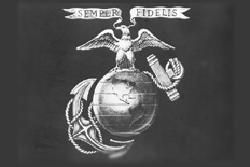Source: Reference Branch, USMC History Division
The history of the Marine Corps emblem is a story related to the history of the Corps itself. The emblem of today traces its roots to the designs and ornaments of early Continental Marines as well as British Royal Marines. The emblem took its present form in 1868. Before that time many devices, ornaments, and distinguishing marks followed one another as official marks of the Corps.
In 1776, the device consisted of a "foul anchor" of silver or pewter. The foul anchor still forms a part of the emblem today. (A foul anchor is an anchor which has one or more turns of the chain around it). Changes were made in 1798, 1821, and 1824. In 1834 it was prescribed that a brass eagle be worn on the hat, the eagle to measure 3 ½ inches from wingtip to wingtip.
During the early years numerous distinguishing marks were prescribed, including "black cockades", "scarlet plumes," and "yellow bands and tassels." In 1859 the origin of the present color scheme for the officer's dress uniform ornaments appeared on an elaborate device of solid white metal and yellow metal. The design included a United States shield, half wreath, a bugle, and the letter "M."
In 1868, Brigadier General Commandant Jacob Zeilin appointed a board "to decide and report upon the various devices of cap ornaments of the Marine Corps." On 13 November 1868, the board turned in its report. It was approved by the Commandant four days later, and on 19 November 1868 was signed by the Secretary of the Navy.
The emblem recommended by this board consists of a globe (showing the Western Hemisphere) intersected by a foul anchor, and surmounted by a spread eagle. On the emblem itself, the device is topped by a ribbon inscribed with the Latin motto "Semper Fidelis" (Always Faithful). The uniform ornaments omit the motto ribbon.
The general design of the emblem was probably derived from the British Royal Marines' "Globe and Laurel." The globe on the U.S. Marine emblem signifies service in any part of the world. The eagle also indirectly signifies service worldwide, although this may not have been the intention of the designers in 1868. The eagle which they selected for the Marine emblem is a crested eagle, a type found all over the world. On the other hand, the eagle pictured on the great seal and the currency of the United States is the bald eagle, strictly a North American variety. The anchor, whose origin dates back to the founding of the Marine Corps in 1775, indicates the amphibious nature of Marines' duties.
On 22 June 1954, President Dwight D. Eisenhower signed an Executive Order, which approved the design of an official seal for the United States Marine Corps. The new seal had been designed at the request of the Commandant of the Marine Corps, Gen Lemuel C. Shepherd, Jr.
The new seal consisted of the traditional Marine Corps emblem in bronze; however, an American bald eagle replaced the crested eagle depicted on the 1868 emblem, and is depicted with wings displayed, standing upon the western hemisphere of the terrestrial globe, and holding in his beak a scroll inscribed with the Marine Corps motto "Semper Fidelis" (Always Faithful) with the hemisphere superimposed on a foul anchor. The seal is displayed on a scarlet background encircled with a Navy blue band edged in a gold rope rim and inscribed "Department of the Navy, United States Marine Corps" in gold letters. Coincident with the approval of this seal by the President, the emblem centered on the seal was adopted in 1955 as the official Marine Corps Emblem.








